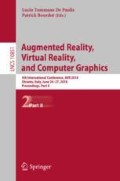Abstract
This paper describes the development of an interactive and motivational tool, to give immersion in the cognitive therapeutic exercise (Perfetti method). This system is implemented with the use of virtual environments developed in the Unity 3D graphic engine. The environments present friendly, novel designs, which are shown to the user in augmented reality with the help of a high-end smartphone and virtual reality headset. In addition, the system helps in the process of recording activities and collecting important data for the monitoring and evolution of the users.
Access this chapter
Tax calculation will be finalised at checkout
Purchases are for personal use only
References
Bryan Kolb, I.W.: Fundamentals of Human NeuroPsychology. Macmillan Publishers, Basingstoke (2009)
De Campos, A.C., da Costa, C.S., Rocha, N.A.: Measuring changes in functional mobility in children with mild cerebral palsy. Dev. Neurorehabil. 14, 140–144 (2011)
Prosser, L.A., Lee, S.C., Barbe, M.F., VanSant, A.F., Lauer, R.T.: Trunk and hip muscle activity in early walkers with and without cerebral palsy – a frequency analysis. J. Electromyogr. Kinesiol. 20, 851–859 (2010)
Oh, S., Bailenson, J.: Virtual and augmented reality. In: The International Encyclopedia of Media Effects (2017)
Rodrigues, J., Cardoso, P., Monteiro, J., Figueiredo, M.: Handbook of Research on Human-Computer Interfaces, Developments, and Applications. IGI Global, Hershey (2016)
Hwang, G., Wu, P., Chen, C., Tu, N.: Effects of an augmented reality-based educational game on students’ learning achievements and attitudes in real-world observations. In: Interactive Learning Environments, pp. 1895–1906 (2015)
Krichenbauer, M., Yamamoto, G., Taketom, T., Sandor, C., Kato, H.: Augmented reality versus virtual reality for 3D object manipulation. IEEE Trans. Vis. Comput. Graph. 24(2), 1038–1048 (2015)
Kerdvibulvech, C., Wang, C.-C.: A new 3D augmented reality application for educational games to help children in communication interactively. In: Gervasi, O., et al. (eds.) ICCSA 2016. LNCS, vol. 9787, pp. 465–473. Springer, Cham (2016). https://doi.org/10.1007/978-3-319-42108-7_35
Sobota, B., Korečko, Š., Jacho, L., Pastornický, P., Hudák, M., Sivý, M.: Virtual-reality technologies and smart environments in the process of disabled people education. In: Emerging eLearning Technologies and Applications (ICETA) (2017)
Lin, C., Chang, Y.: Interactive augmented reality using Scratch 2.0 to improve physical activities for children with developmental disabilities. In: Research in Developmental Disabilities, pp. 1–8 (2015)
Suzuki, K.: Augmented human technology. In: Sankai, Y., Suzuki, K., Hasegawa, Y. (eds.) Cybernics: Fusion of Human, Machine and Information Systems. LNCS, pp. 111–131. Springer, Tokyo (2014). https://doi.org/10.1007/978-4-431-54159-2_7
Serrano, C.V., Bonilla, I., Gomez, F.V., Mendoza, M.: Development of a haptic interface for motor rehabilitation therapy. In: Engineering in Medicine and Biology Society (EMBC), 37th Annual International Conference of the IEEE, pp. 1156–1159 (2005)
Lin, C., Chai, H., Wang, J., Chen, C., Liu, Y., Chen, C., Lin, C.-W., Huang, Y.-M.: Augmented reality in educational activities for children with disabilities. Displays 42, 51–54 (2016)
Robson, N., Faller, K., Ahir, V., Ferreira, A., Buchanan, J.: Creating a virtual perception for upper limb rehabilitation. Int. J. Biomed. Biol. Eng. 11, 152–157 (2017)
Hsiao, K., Rashvand, H.: Data modeling mobile augmented reality: integrated mind and body rehabilitation. Multimed. Tools Appl. 74, 3543–3560 (2013)
Ravi, D., Kumar, N., Singhi, P.: Effectiveness of virtual reality rehabilitation for children and adolescents with cerebral palsy: an updated evidence-based systematic review. Physiotherapy 103, 245–258 (2017)
Kolar, P., et al.: Clinical Rehabilitation. Alena Kobesová, Prague (2014)
De Cecco, M., et al.: Augmented reality to enhance the clinician’s observation during assessment of daily living activities. In: De Paolis, L.T., Bourdot, P., Mongelli, A. (eds.) AVR 2017. LNCS, vol. 10325, pp. 3–21. Springer, Cham (2017). https://doi.org/10.1007/978-3-319-60928-7_1
Hatem, S., Saussez, G., Faille, M., Prist, V., Zhang, X., Dispa, D., Bleyenheuft, Y.: Rehabilitation of motor function after stroke: a multiple systematic review focused on techniques to stimulate upper extremity recovery. Front. Hum. Neurosci. (2016)
Manzanares, M., Galán, C., Morales, N., Guerrero, E.: Sensitive reeducation of the hand. In: Fisioterapia, pp. 114–122 (2004)
Lv, Z., Esteve, C., Chirivella, J., Gagliardo, P.: A game based assistive tool for rehabilitation of dysphonic patients. In: Virtual and Augmented Assistive Technology (VAAT), pp. 9–14 (2015)
Acknowledgements
We thank the “Universidad de las Fuerzas Armadas ESPE” for financing the investigation project number 2016-PIC-0017.
Author information
Authors and Affiliations
Corresponding author
Editor information
Editors and Affiliations
Rights and permissions
Copyright information
© 2018 Springer International Publishing AG, part of Springer Nature
About this paper
Cite this paper
Pruna, E., Escobar, I., Acurio, A., Cocha, H., Bucheli, J., Mena, L. (2018). Augmented Reality System for the Complement of Cognitive Therapeutic Exercise in Children: Preliminary Tests. In: De Paolis, L., Bourdot, P. (eds) Augmented Reality, Virtual Reality, and Computer Graphics. AVR 2018. Lecture Notes in Computer Science(), vol 10851. Springer, Cham. https://doi.org/10.1007/978-3-319-95282-6_18
Download citation
DOI: https://doi.org/10.1007/978-3-319-95282-6_18
Published:
Publisher Name: Springer, Cham
Print ISBN: 978-3-319-95281-9
Online ISBN: 978-3-319-95282-6
eBook Packages: Computer ScienceComputer Science (R0)

